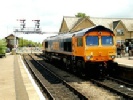Archive Section




An account of the lecture by Peter Summerhays of South West Trains on Tuesday 4th April 2000, written by Peter Lindop.
Our April meeting speaker was Peter Summerhays, Director New Build at Southwest Trains (SWT). For about the past two years he has been involved with the class 458 units.
Peter started with some background history: during British Rail's privatisation no new passenger trains having been built for three years, and the Porterbrook ROSCO being bought by Stagecoach. SWT went out to tender in November 1996 for a fleet of 30 4-
For SWT the units would be 4-
458 001 was delivered on 31 October 1998, full instrumented, and began test running in December. All trips were recorded on tape and provided plenty of good data.
Peter spoke about and illustrated some of the problems found during testing. The gap between the stepboard and the platform edge (No. 7 at Clapham Junction) was shown. All along it varied both in width (or lack of) and height difference! All this variation was from just one platform and showed Railtrack that they don't have consistency on the system!
One unit was taken to Reading to check signal location and driver sighting, but as Great Western Trains were uncertain about interference to their adjacent tracks, the unit had to be hauled there and back. The test proved the signal had to be moved.
New regulations about access for the disabled came into force during the delivery time but although they had not entered service, not many changes needed to be made. They failed to comply (sometimes in small detail) on seating, handrail, labelling and door button dimensions. The toilet area, although large, is still smaller than the new regulations state.
SWT is keeping guards on these trains, not only for passenger security, but also if required to help with the disabled.
Maintenance costs should come down. As the unit comes into Wimbledon Depot cameras in the track are able to check the size of shoegear and brake disc pads, and wheel profiles, along with the unit's identity. A complete history can be built up, and any trends can be spotted and acted on before damage is done. The traction motor gearbox oil level sight glass is about the only item that physically needs to be checked! Disc pads should go about 60,000 miles between changes. Units should be programmed to go 90 days between depot maintenance visits. A new stores building is being built at Wimbledon. The onboard computer system (TMS) is able to record and identity faults, making the driver's job easier. An interactive CD ROM manual has been produced, allowing maintenance staff to go down step by step from the complete train almost to every part in pictures or words. It also contains engineering drawings and is updated by Alstom. The first train entered service on 25 February 2000, having just gained the Railtrack Safety Case and a London Underground Limited Neighbouring Agreement. The class 458 was the first electric train to attempt and achieve the Safety Case; at times a difficult progress.
Peter gave us an interesting and well-
|
If you have enjoyed this article, you may also be interested in the following articles by the same author: |
|
|
You maybe interested in the subsequent L&CI visit to Wimbledon Park depot |
|